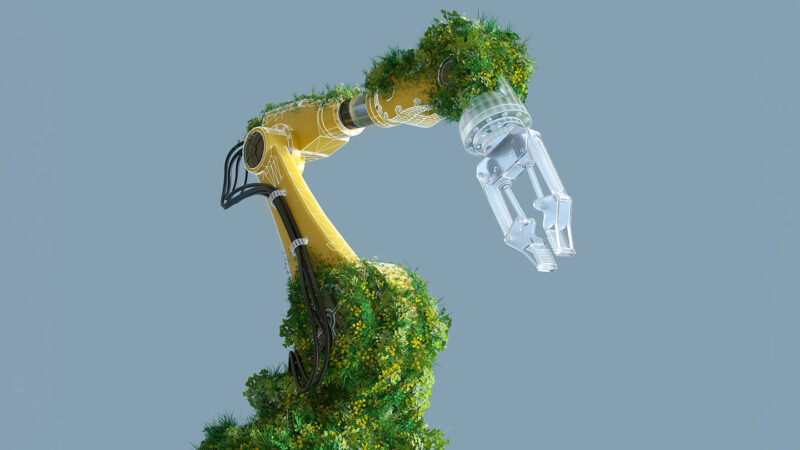In the TV series Doctor Who, treeborgs supply fresh air to spaceship passengers. Part tree, part robot, these devices convert starlight into oxygen. In Nnedi Okorafor’s novel Zahrah the Windseeker, children receive their own “flora computers.” These are personal machines made of leaves and vines, grown from CPU seeds and shaped into useful tech.
Although these devices may be fictional, flower-powered machines are getting real. This new generation of devices are examples of biohybrid technology. That’s a term for any device that merges artificial parts with living tissue.
Engineers have strived to make robots that work like living things. But re-creating the complex functions of, say, a hand or leaf is impossible with synthetic materials, says Anand Mishra. He’s an engineer at Cornell University in Ithaca, N.Y. “There is a point where technology limits us.”
Using life-forms to build machines can overcome some limits of human technology, though. Researchers like Mishra are looking at how fungi and plants can give machines abilities they couldn’t achieve with electronics alone.
Fungal feelings
Living tissue has evolved all sorts of ways to scope out its environment. Think of your own body. You can see light, feel warmth, smell and taste the molecules in food. Mishra aims to use living tissue to make robots that are similarly sensitive to their surroundings. But instead of animal tissue, he’s using fungi.
Fungi tend to grow faster than animal cells. Some are also quite good at surviving harsh conditions such as cold, radiation and salty environments. Animal cells tend to be a lot more sensitive. “To cultivate animal cells, you probably have to be a biologist,” says Mishra. Mushrooms are easy to grow at home.
Fungi aren’t plants. They’re more closely related to animals. But Mishra used one of fungi’s most plantlike features, mycelia, to help his bots sense their surroundings. Fungi use these rootlike structures to tunnel through soil for nutrients. Mycelia also detect environmental cues such as light, heat and chemicals.
Anand Mishra’s team has used structures from fungi, called mycelia, in a biohybrid robot.A. Mishra
Mishra’s team grew mycelia directly into electrodes attached to two robots. The fungi communicated with the robots through electrical signals called action potentials. These zaps are similar to those produced by heart and nerve cells.
Mycelia produce spontaneous action potentials. These random bursts of electricity triggered the biobots to walk and roll around. But when flashed with ultraviolet light, the mycelia produced stronger electrical zaps. This changed the robots’ gait, showing that they could respond to their environment.
Using fungi in biohybrid robots is still “pretty new,” Mishra says. His team now hopes to test how such tech responds to other cues, such as gases and chemicals. One day, their robots’ sensory superpowers might help out in agriculture. Future shroom bots may walk through crop fields, testing soil health and other conditions as they go.
Plant persistence
While fungi may help robots better interact with the world, plant powers could help devices better survive it.
“Many artificial [technologies] have a shelf life,” says Fabian Meder. This materials scientist works at the Sant’Anna School of Advanced Studies in Pisa, Italy. Electronics start to break down in a few years. Yet the oldest living trees can stand tall for thousands of years. When it comes to longevity, this makes plants the clear winner, says Meder. And while broken electronics require repairs, plants can recover from damage.
In his own research, Meder has witnessed firsthand the difference in durability between plants and electronic parts. Meder has designed artificial leaves that tap an unlikely energy source: static electricity. This type of electric charge is created when two objects touch, then separate.
To harvest static electricity created by wind, Meder places artificial leaves on plants. The fake leaves include a layer of rubber — a material good at building up static charge. When wind rustles one of these bionic plants, the artificial leaves bump into real leaves. This creates static charges that pass into the inner tissue of the real plant leaf, producing a current. This energy can be harvested through electrodes placed in the plant leaf. Meder’s studies have shown that such devices can light up LED lights.
Meder’s energy-harvesting tech relies on both plastics and plants to get the job done. “You may think that the plant is [the] fragile part, but it’s actually not,” says Meder. It’s “the artificial part which usually fails.” Mishaps such as cable breaks pose the biggest problem. And once a piece of gear is broken, it needs to be repaired. The plants, though, can adapt to different environments and heal themselves.
Working with living materials does pose some extra design challenges. For one thing, it requires keeping those living parts alive, says Meder. Like fungi, plants need certain resources to stay healthy. “Photosynthesis is a big part of that.” To accommodate that need, engineers might use transparent materials to make parts that would otherwise block out sunlight. Or they might use lighter materials that don’t weigh leaves down.
Certain plants would work better with Meder’s system than others. Evergreen trees, which keep their leaves throughout the year, are more ideal than deciduous plants that lose their leaves during winter. But Meder is excited about this new way to tap a potential energy source. “It’s always about harvesting [these] crumbs of energy which we otherwise would just lose.”
Almost like those Doctor Who treeborgs surviving on the light of faraway stars.




